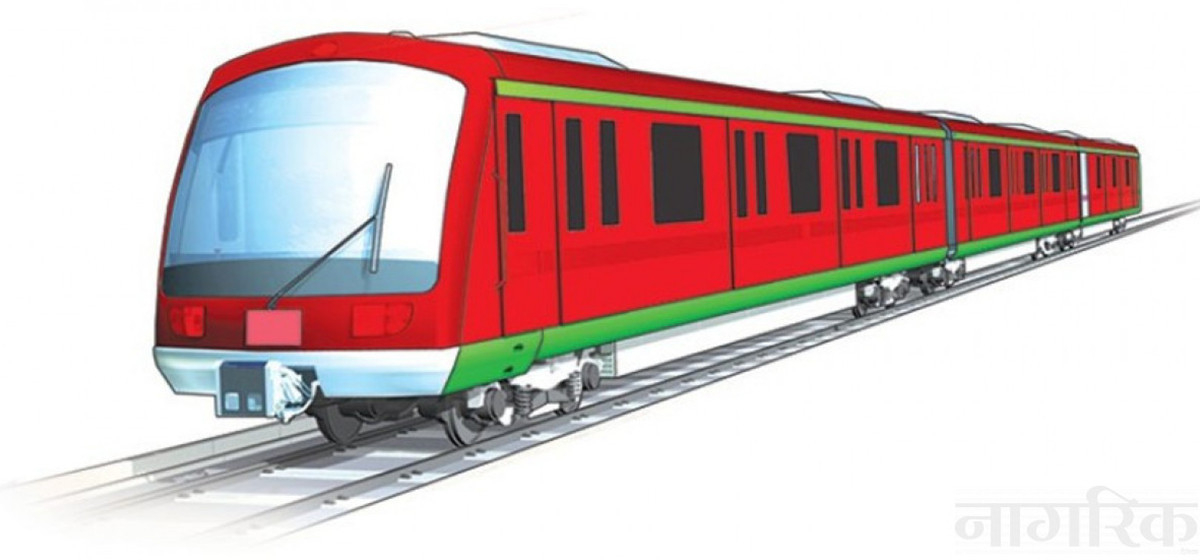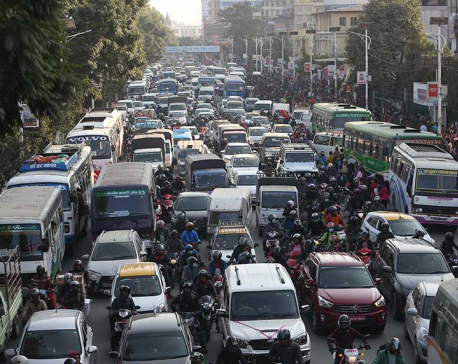
OR

KATHMANDU, Aug 24: Escalating traffic congestion and chaos have made traveling a challenging endeavor, with both public and private vehicles frequently ensnared in gridlocks. To address this issue, political parties have presented the vision of introducing monorail and metro rail systems in the Kathmandu Valley. Nearly two decades have passed since railway plans were set in motion. Following the political transformation of 2006, political parties began weaving promises of rail-based solutions into their electoral agendas.
In 2011, a comprehensive feasibility study was conducted for a railway network within the valley. The study identified the feasibility of operating metro rails on five distinct routes. However, despite the completion of the study, progress on its implementation has remained stagnant.
Now, Physical Infrastructure and Transport Minister Prakash Jwala has rejuvenated the proposal to establish a metro train system in the Kathmandu Valley. Expressing optimism about potential Russian involvement, Minister Jwala has extended an invitation to a delegation led by Russia's ambassador to Nepal, Aleksei Novikov, to collaborate on the metro train initiative. This proposition has been made ahead of the visit of Vyacheslav Volodin, chairperson of the State Duma of the Federation Assembly of the Russian Federation, to Nepal.
Highlighting Russia's global renown for its railway expertise, the Ministry of Physical Infrastructure underscored the significance of seeking assistance from the country. Keshav Kumar Sharma, secretary of the Ministry of Physical Infrastructure and Transport, affirmed discussions with the Russian ambassador, stating, "We've proposed the construction of a metro rail system. The response from Russia is promising." Sharma revealed that a detailed project report (DPR) could be formulated based on previous preliminary studies.
In 2011, a pre-feasibility study conducted by a Korean consulting company on the government's behalf identified five potential routes for the train network. These routes encompassed trajectories such as Satdobato-Pulchowk-Tripureshwar-Ratnapark-Narayanhiti-Maharajganj to Narayan Gopal Chowk, Kalanki-Kalimati-Maitighar-Tinkune to the airport, the ring road, an underground route from Swayambhu to Gongabu, and Dhobighat-Pulchowk-Patan Durbar-NewBaneshwar-Maitighar-SinghaDurbar-Sahidgate-Dillibazar-Tangal-Narayanhiti-Nayabazar to Gongabu.
Subsequent to this, a preliminary study conducted by the Japan International Cooperation Agency (JICA) in 2017 proposed two viable lines for the metro train: a north-south route from Narayan Gopal Chowk to Satdobato, and an east-west line from the Airport to Kalanki.
These efforts received a boost from the findings of a report commissioned by the Investment Board and conducted by a foreign firm. The study affirmed the feasibility of a Metro Rail system, suggesting extensions of the Koteshwor-Kalanki metro line to Dhulikhel and from Narayan Gopal Chowk to Satdobato, ultimately linking Budhanilkantha to the Kathmandu-Terai fast track.
A committee led by former member of the National Planning Commission, Hitendraman Pradhan, also drafted a report outlining the feasibility of connecting the fast track through routes like Budhanilkantha-Narayan Gopal Chowk-Satdobato and extending it to Dhulikhel via Nagadhunga-Kalanki. Regrettably, these study reports are gathering dust in government shelves.
The Railway Department has acknowledged that while a consultant has been engaged to conduct an exhaustive Detailed Project Report (DPR) for a metro rail route encompassing Satdobato-Pulchowk-Tripureshwor-Ratnapark-Narayanhiti-Maharajgunj to Narayan Gopal Chowk, the progress has been sluggish. Aman Chitrakar, Senior Divisional Engineer at the department revealed that despite the identification of five prospective routes, the formulation of the DPR for the primary route remains incomplete. He pointed out that even though an agreement was in place, the construction of the DPR was halted due to various factors such as local governance dynamics and cultural considerations.
Chitrakar strongly advocated the imperative of establishing rail infrastructure, underscoring the pressing need given the valley's burgeoning population and escalating traffic challenges. He highlighted that with a population of 4-5 million in the valley, a metro rail system has become a necessity. "Efficient mass transportation is imperative within the valley," he emphasized, further stressing the importance of long-term railway planning.
Despite the government's proposition to Russia for assistance in building a metro rail system, skepticism looms among experts regarding its completion. Evaluating the country's economic capacity and the resolve of political leadership, experts are skeptical about the feasibility of advancing railway construction.
Transport expert Ashish Gajurel expresses skepticism about the immediate feasibility of constructing a metro rail system in the valley. Gajurel pointed out that the government's current management of public transportation has been lacking, and there appears to be a lack of readiness in terms of technology, economy, and planning for building a metro. He emphasized the high operational costs associated with running a metro, which poses a challenge for Nepal considering its financial constraints. Given the difficulties in meeting employee salaries and other pressing expenses, he believes it's unlikely that Nepal can allocate such a significant budget for metro rail construction, especially since the cost can amount to around 12-13 billion rupees per kilometer.
Infrastructure expert Dr Surya Raj Acharya underlines the necessity of a metro rail system due to the escalating vehicle pressure and chaotic traffic situation in the valley. However, he acknowledges the intricate balance between investment and budget constraints. He questions whether the government can allocate funds for railways when essential projects are facing budgetary challenges. Acharya highlights the urgent need for organized public transport to maintain economic activity and boost production.
While some experts suggest the possibility of a public-private partnership for operating the metro train, it appears difficult to attract investment in Nepal. The reluctance of domestic investors to invest in long-term projects without immediate returns and the limited foreign investment opportunities hinder the prospects for railway investments.
Local representatives advocate for the metro rail, seeing it as an essential solution. Chiribabu Maharjan, mayor of Lalitpur Metropolitan City, believes that even though the metro project might be costly, it shouldn't be dismissed. He argues that preparations should begin immediately, as it could take a decade or more to complete. He cites the valley's growing population as a driving factor, projecting a population of six million within 15 years, thus necessitating the presence of a metro rail system.
Mayor Maharjan's proposal to Kathmandu Mayor Balendra Shah, suggesting collaborative leadership for the metro rail construction, has been met with interest. Shah acknowledges the importance of a metro system and intends to initiate discussions regarding its feasibility. He had also highlighted the metro rail plan in local elections and the annual policy and program of the Kathmandu metropolis. A Kathmandu Valley Metro Rail Promotion Group has also been established, comprising experts working towards this endeavor.
You May Like This

‘Pick and drop rule’ for passenger vehicles enforced around Tundhikhel area
KATHMANDU, Dec 17: As traffic police enforced pick and drop rule in the core city areas in Kathmandu including Jamal,... Read More...

Drivers' carelessness behind 90% road accidents
KATHMANDU, Aug 26: Most of the road accidents have occurred due to drivers' carelessness in the Kathmandu Valley. ... Read More...

15 air quality monitoring equipment to be installed in Kathmandu Valley
KATHMANDU, July 27: The Department of Environment (DoE) under the Ministry of Science, Technology and Environment (MoSTE) is all set... Read More...











Just In
- Challenges Confronting the New Coalition
- NRB introduces cautiously flexible measures to address ongoing slowdown in various economic sectors
- Forced Covid-19 cremations: is it too late for redemption?
- NRB to provide collateral-free loans to foreign employment seekers
- NEB to publish Grade 12 results next week
- Body handover begins; Relatives remain dissatisfied with insurance, compensation amount
- NC defers its plan to join Koshi govt
- NRB to review microfinance loan interest rate







Leave A Comment